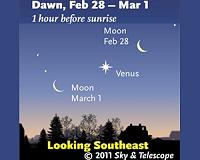 |
Moffett Field CA (SPX) Feb 25, 2011 Forty years after the first lunar rover rolled across the moon's surface, 84 teams of enterprising future engineers will demonstrate the same ingenuity and can-do spirit at the 18th annual NASA Great Moonbuggy Race, set for April 1-2 in Huntsville, Ala. The event challenges high school and college students to design, build and race lightweight, human-powered rovers - "moonbuggies" - which address many of the same engineering challenges dealt with by Apollo-era lunar rover developers in the late 1960s. Teams include U.S. high school, college and university students from 22 states and Puerto Rico; and international challengers from six countries, including returning teams from Canada, India and Germany and - for the first time - racers from Ethiopia, Pakistan and Russia. For a complete list of competitors, visit: http://moonbuggy.msfc.nasa.gov/email.html The race is organized each year by NASA's Marshall Space Flight Center and hosted at the U.S. Space and Rocket Center, both in Huntsville. It commemorates the NASA Lunar Roving Vehicles - engineering marvels designed and tested at Marshall from 1969-1971. The first rover made its inaugural excursion on the moon's surface July 31, 1971, driven by Apollo 15 astronauts David Scott and James Irwin. Two more rovers followed in 1972, enabling still greater scientific exploration during the Apollo 16 and Apollo 17 missions. Four decades later, student teams competing in the NASA Great Moonbuggy Race strive to uphold that engineering tradition. Their challenge is to deliver a two-driver buggy - usually in a three- or four-wheeled configuration - capable of posting the fastest vehicle assembly and race times, while incurring the fewest penalties on a harrowing course that simulates the harsh, rocky lunar surface. High school students square off in one division; college and university teams compete in another. Prizes are awarded to the three teams in each division that finish fastest, with the least number of penalties. NASA and industry sponsors also present a variety of additional awards, including honors for Rookie of the Year and the Featherweight award for the lightest, fastest buggy. Participation in the race has increased annually from just eight college teams in 1994 - the high school division was added two years later - to more than 70 high school and college teams in 2010. "Hailing from four continents, the aerospace talent of tomorrow comes together for this hands-on engineering competition," said Dr. Frank Six, the university affairs officer at the Marshall Center and one of the founders of the NASA Great Moonbuggy Race. "More importantly, they'll come to meet one another, to turn school projects and shared dreams of spaceflight into lasting friendships and future partnerships. "We are proud to continue NASA's long tradition of inspiring and engaging young people around the world to dream big, to innovate and to work together to seek a better, brighter future for us all," he added. This year's event could inspire more young people than ever before. NASA will broadcast live race coverage via NASA TV and the online Webcasting service UStream. In 2010, more than 32,000 people around the world watched live coverage, including commentary from race organizers and chats with student racers. To watch video of the 2010 competition, visit: http://www.ustream.tv/channel/the-great-moonbuggy-race-2010 The NASA Great Moonbuggy Race is one of numerous education projects and initiatives conducted by the agency each year to spark young people's interest in science, technology, engineering and math - and encourage them to pursue careers as America's next scientists, engineers and explorers. The Academic Affairs Office in the Marshall Center's Office of Human Capital manages the event. Major race sponsors include Lockheed Martin Corporation, The Boeing Company, Northrop Grumman Corporation and Jacobs Engineering ESTS Group, all with operations in Huntsville. Other sponsors include the ATK Aerospace Systems of Magna, Utah; the Huntsville operations of Science Applications International Corporation, Teledyne Brown Engineering and Davidson Technologies; and the American Institute of Aeronautics and Astronautics.
Share This Article With Planet Earth
Related Links NASA Great Moonbuggy Race Mars News and Information at MarsDaily.com Lunar Dreams and more
 Venus And Crescent Moon Pair Up At Dawn
Venus And Crescent Moon Pair Up At DawnLos Angeles CA (SPX) Feb 23, 2011 The brightest planet and the eerie waning crescent Moon will create an arresting sky scene low in the southeast in the early dawn of Monday, February 28th, and Tuesday, March 1st, 2011. "These are the two brightest astronomical objects in the sky after the Sun," says Alan MacRobert, a senior editor of Sky and Telescope magazine. "They'll certainly catch your eye, if you look low in the sou ... read more |
|
| The content herein, unless otherwise known to be public domain, are Copyright 1995-2010 - SpaceDaily. AFP and UPI Wire Stories are copyright Agence France-Presse and United Press International. ESA Portal Reports are copyright European Space Agency. All NASA sourced material is public domain. Additional copyrights may apply in whole or part to other bona fide parties. Advertising does not imply endorsement,agreement or approval of any opinions, statements or information provided by SpaceDaily on any Web page published or hosted by SpaceDaily. Privacy Statement |